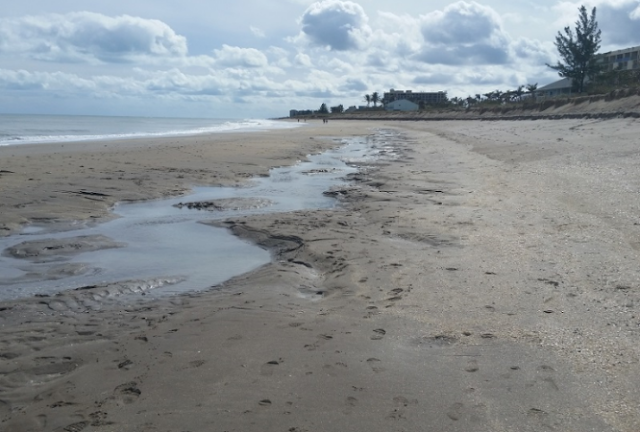Written by the TreasureGuide for the exclusive use of treasurebeachesreport.blogspot.com.
 |
| Fort Pierce South Jetty Park Monday Photo by Gaylen C. |
Gaylen C. sent in these great photos of South Jetty Park. They show the different zones of the beach and how different types of material get piled up in different areas. The same thing happens with coins and other objects. They are distributed according to density, shape and the force of water as it increases and decreases at different locations.
 |
| South Jetty Park Monday Photo by Gaylen C. |
Here is how Gaylen described it.
Went to check out Fort Pierce again. This was a completely different look as far as the beach went . Very wide low tide, there was a long trough running down the beach that was probably the first drop off under the waves yesterday. A long, wide band of shells ran near the waters edge. A couple of really big scalloped areas to the south, which started an increasing south to north flow in the trough as the tide started to come in. Lot's of debris, a couple of the black sandbags. The dunes had been cut back to vertical and 7-8 ft again at the north end near the jetty, but looked more filled in ,or collapsed, going south. saw one other detectorist in the north corner. I went first to the trough, then the shells at the waters edge. Sand was like quicksand along most of the ocean side of the trough. Really soft dark sand.
 |
| Fort Pierce South Jetty Park Monday. Photo by Gaylen C. |
Thanks for sharing Gaylen. Great photos.
---
 |
| Nearly Antique Tumbler With Newly Cleaned Coins. |
Be careful about the coins you tumble. If a coin is encrusted or something so that you have no idea what it is, don't just throw it in the tumbler. I once made the mistake of tumbling an old 1715 Fleet pendant that looked like an encrusted coin before it was tumbled. Good idea to check the coins frequently too. No use in over tumbling. For clad you just want them clean enough to inspect and spend. You don't want to tumble nice old coins or other objects.
---
For the first time in 150 years you will have the chance to see a Super Blue Blood Moon on January 31.
...The last Blue Moon occurred in July 2015 and in 2018, we'll experience two of them, a phenomena that won't happen for another 19 years. The second Blue Moon is slated to occur in late March.
The Blood Moon occurs because the Earth is passing between the Moon and the Sun, which gives the Moon a reddish tint to it. It's caused by light bending around the Earth because of gravity passing around a portion of the atmosphere, more commonly known as a lunar eclipse.
A Blue Moon combined with a Supermoon (when the Moon is at its closest point to Earth and appears to be 14 percent bigger and 30 percent brighter than normal) the rare phenomena is called a Super Blue Blood Moon happens. Supermoons generally only occur once every 14 months and will not happen again until January 2019...
Here is the link for more information about that.
http://www.foxnews.com/science/2018/01/29/super-blue-blood-moon-2018-what-when-and-where.html
Along with all of that, we are going to have some big high and low tides. You can see the nice low tides that have already started in the photos today.
Happy hunting,
TreasureGuide@comcast.net